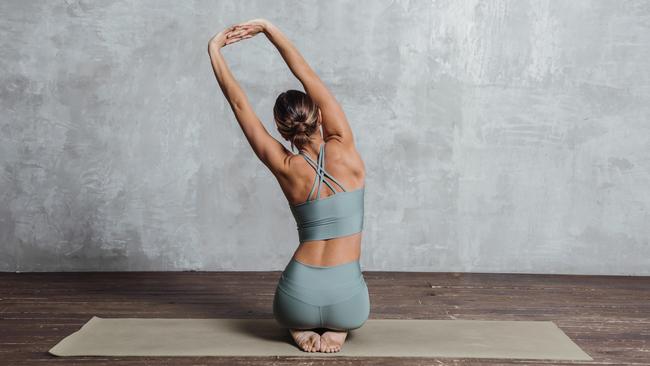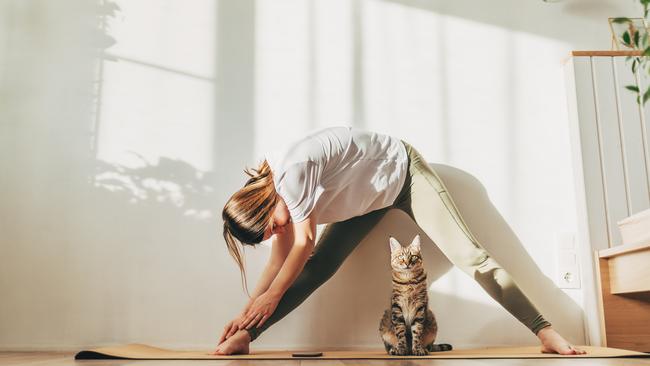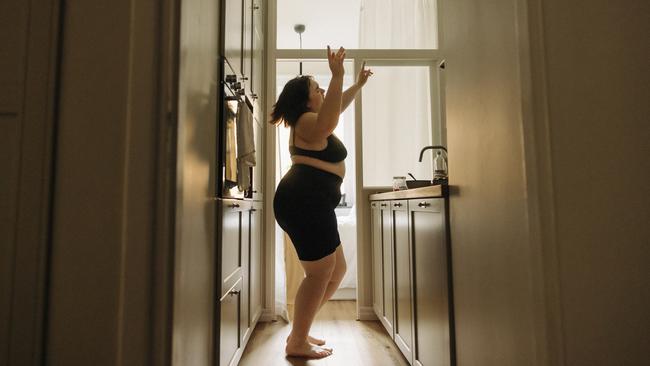These easy stretches could help you live longer
If your focus on stretching goes no further than tying your shoelaces then the results of a new large-scale study make for a sobering read.

If your focus on stretching goes no further than tying your shoelaces then the results of a new large-scale study looking at the links between flexibility and mortality may make for a sobering read.
In the first investigation of its kind, an international team of researchers from institutions including University of Leicester and the University of Eastern Finland kept track of more than 3,000 middle-aged men and women for a decade.
Claudio Gil S Araujo, lead author and director of research and education at Clinimex, an exercise medicine clinic in Rio de Janeiro where the data was collected and analysed, says that the results show that the more flexible you are, the more likely you are to live longer.
Araujo is one of the world’s leading flexibility scientists. For this latest research, published in the Scandinavian Journal of Medicine and Science in Sports and Exercise, he first asked participants to complete his Flexitest, a scientifically evaluated assessment of 20 stretches to test overall flexibility, then followed them for a decade. Those with the stiffest joints were shown to be at a greater risk of dying early than people who retained a level of suppleness.
Genetics play a part in determining how flexible we are and, at 68, Araujo says he was blessed with genes that allow him to stay mobile. But, he says, we can’t rely on natural flexibility and lifestyle plays a part in preserving elastic and mobile muscles and joints. Age, injuries and wear and tear all take their toll, but we need to stretch.
“We now know that flexibility is a bit like a biological clock. You can estimate a person’s biological age and how long they are likely to live by assessing how flexible they are at different stages of life.” - Claudio Gil S Araujo
A big gripe of Araujo’s is how much this is overlooked by the fitness industry. “When you go to a gym, you are assessed for aerobic fitness and for strength, but not for flexibility and it is always an afterthought,” he says.
Each of us has specific flexibility strengths and failings. “Women are, on average, 25 per cent more flexible than men thanks to differences in hormones and connective tissue,” Araujo says. “But while one person needs to focus on shoulder stretches, another might need to develop ankle or trunk range of motion and it’s important to identify where your weakness lies.”
His research has confirmed how important flexibility is for health, affecting not only our posture and ability to protect ourselves from falls as we age (bendy people bounce whereas inflexible people crash when they fall) but also influencing our risk of heart and metabolic disease.
“We now know that flexibility is a bit like a biological clock,” he says. “You can estimate a person’s biological age and how long they are likely to live by assessing how flexible they are at different stages of life.”
Most midlifers would not score highly on his Flexitest, but the good news is that improvements come quickly. “Five minutes of stretching a day can transform your health and help you live longer,” Araujo says. Here’s how.
Start stretching now to preserve mobility
Whereas our muscle strength and bone density gradually increase until our thirties, it is a different story for our flexibility. “We start to lose our flexibility from the moment we learn to walk,” Araujo says. “There is a gradual and continual decline in flexibility as we age until the end of life, so it is really important to work at stalling this drop as much as we can.”
In one of his early studies, involving 6,000 people aged 5 to 92, Araujo showed that age-related loss of mobility is joint-specific with the greatest losses in shoulder and trunk flexibility from our thirties onwards. Shoulder flexibility in 28-year-old men was 13.9 per cent but that dropped to 5.2 per cent at 85 years of age.
Doing as little as five minutes of daily exercises in which each stretch is held for 15 or 30 seconds will help. “You can do it anywhere and can make up your own stretching routine, varying the muscles you focus on each day,” Araujo says.
The effects can be dramatic. Men in their sixties who started stretching tight hamstrings five times a week for six weeks showed an increase in range of motion by up to 2.4 degrees each week according to a study in Physical Therapy journal.
Stretch your calf muscles before a workout to enhance blood vessel health

Doing a few passive stretches before a workout makes your blood vessels more resilient to the stress of exercise. That was the main finding of a 2023 study at the University of Wisconsin La Crosse (UWL) in which lead author Jacob Caldwell, assistant professor of exercise and sport science at UWL, asked some participants to perform a passive calf stretch before an indoor cycling session.
Passive stretches involve an external force to hold a muscle stretch of several seconds or even minutes, ideally repeated 3-4 times. In the experiment a specially made boot was used, but Caldwell says using a towel or yoga strap has the same effect. To do this, sit with legs straight and loop a strap around the ball of your right foot, holding the ends of the strap with your hands. Pull on the strap to feel a stretch on the calf.
A control group did no stretching before completing the workout. Results, published in the Journal of Applied Physiology, showed the flexibility exercise helped retain good blood vessel function. “Unlike some forms of aerobic exercise, passive stretching can be performed in much of the population,” Caldwell says. “And it seems that improvements in cardiocirculatory function are worth the stretch.”
Do a stretch session five times a week for heart health
A regular stretching routine may enhance the health of your arteries, potentially helping reduce the risk of heart disease. Like muscles and tendons, our arteries are dynamic connective tissue and can stretch and tighten under pressure. In theory they could benefit from physical dynamic loading in a similar way to muscles, and that was the focus of a trial at the University of Milan’s department of biomedical sciences for health.
Researchers there assigned 39 healthy participants to either a “stretching group’‘, who performed leg stretches five times a week, or a control group, who did no stretching. The exercises included hip extension, knee flexion and ankle dorsiflexion performed in different positions (standing, lying, with flexed or straight leg), each stretch held for 45 seconds with a 15-second rest in between.
Throughout the 12-week trial, researchers tracked how the stretch programme affected blood flow in the legs and in the upper arms, with results, published in the Journal of Physiology, showing that the routine restored some of the youthful attributes of arteries by decreasing their stiffness and making it easier for them to dilate. “There’s quite a lot of evidence that loading arteries through passive stretches is good for our vascular health,” Araujo says.
Try ten minutes of static stretching to boost your mood
Static stretching differs from passive stretching in that you perform the stretch unaided by a partner or accessories such as straps and belts. Typically, these stretches are held for a set time and can bring mind as well as body benefits by promoting relaxation and reducing the production of stress hormones such as cortisol.
When a group of sedentary young adults performed just ten minutes of whole-body stretching using yoga techniques and poses, it produced an immediate upswing in mood and cognitive function when compared with those in a non-stretching control group, according to a study in Perceptual and Motor Skills journal.
Others have shown that done regularly, static stretching reduces feelings of anxiety and depression. Office workers who started doing a ten-minute stretch session after work reported a reduction in anxiety, body aches and pain and exhaustion after three months.
If you don’t like stretching, try dancing instead

Two studies last year showed that dancing enhances mobility and flexibility in adults of all ages. Araujo is a fan. “Dance, whether an organised class or just doing it yourself, is a great way to work on muscle flexibility,” he says. “You are moving and stretching joints in different directions all the time, which makes it a wonderful means of staying strong and mobile.”
Six ways to assess your flexibility
In the Flexitest used in all of his stretching studies, Araujo conducts extensive assessments using 20 different stretches under laboratory conditions. However, there are some that you can do at home (preferably with the help of a partner) to test your suppleness. Do these every few months and see how regular stretching improves your overall flexibility. Score your position from 0 to 4. A score of 2 is average.
Ankle dorsiflexion
Lie or sit on the floor with your right leg relaxed and fully extended and toes pointed upwards. Without using your hands, pull your toes toward your body. It can be helpful to ask a partner to place one hand above your knee and their other hand at the ball of your foot, applying pressure to help guide the toes inwards. Don’t worry if your heel lifts off the ground. A right angle between the foot and the calf gets a score of 1. Get your toes past a 90-degree angle and you get 2, getting toes closer to the shin is a 3 or 4. Repeat on the left side.
Hip flexibility
Lie on the floor with arms stretched above your head and left leg bent, left foot flat on the floor. Your right leg should be fully extended. Angle your left knee as far back to the floor beside your chest as you can. Get your partner to keep your right leg in pace and to apply some pressure to the left shin to help you to maximise the stretch. Make sure your hips don’t rotate by keeping your buttocks on the floor. Score 1 if you can raise your knee at right angles to your torso and 4 if you can place your knee almost on the floor next to your chest. Repeat both sides.
Shoulder flexibility
From a standing position, reach your right arm over the top of your head by bending at the elbow, and aim to touch opposite shoulder. Score 1 if you get close and 2 if you make contact with the left shoulder. To further the stretch tell your partner to press gently on your upper back and steer your right hand towards your left shoulder blade. Make sure you don’t twist your trunk at any time. Score 4 if you can touch the shoulder blade, 3 if you get close. Repeat on the other side.
Wrist flexibility
Straighten your left arm in front of the body, parallel to the floor. Extend your outstretched hand back towards your chest as far as you can, asking a partner to support your elbow and apply pressure to the palm to maximise the stretch. (Score 1 if you can raise your hand to right angles with the forearm and 4 if you can stretch it backwards to approximately 45 degrees. Repeat on the other arm. To test wrist flexion, repeat the assessment but stretch the palm underneath the forearm towards the chest.
Trunk flexion
Sit on the floor facing a wall, with your bottom as close to it as possible and your legs fully extended up the wall to form a right angle with the trunk. Bend arms and join hands lightly together at the back of the neck. Keeping buttocks on the floor at all times, raise your trunk towards your legs. If you can’t reach off the floor without flexing your knees, your score is 0. If only the upper back moves off the floor, score 1 but if there is some lower back motion, your 3. A 4 is awarded when you can place chest and trunk on your thighs.
Trunk range of extension
Lie face down on the floor with both legs extended and hands joined at the back of your neck. Aim to lift your head and trunk off the floor as far as possible. Ask a partner to kneel or stand over you with hands on your shoulders to help maximise the trunk extension. If you can’t raise your head and trunk off the floor without assistance, score 0. If you raise trunk almost to right angles with the floor, score 4.
The Times




To join the conversation, please log in. Don't have an account? Register
Join the conversation, you are commenting as Logout